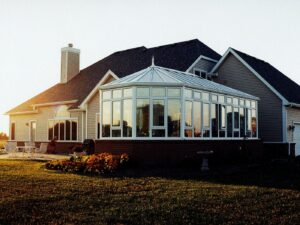Quick tips for all-seasons sunroom construction
A sunroom helps you expand your home’s interior further into the Great Outdoors. But what happens when scorching summer heat or frigid winters make the outdoors seem a lot less great? When building a sunroom, it’s important to think about what happens to your room when conditions outside become downright hostile – and what measures you can take to make your room comfortable during all the time you want to use it.
But first, let’s start with some good news. A true four-season sunroom is designed to be used during every season, pure and simple. Unless you call the Arctic Circle home or live happily in the borders of Death Valley, it should stay every bit as comfortable as the rest of your home, even during seasonal extremes.
Because of advances in technologies used for energy efficient glass coatings, multi-pane insulated windows, and insulated vinyl structures, a sunroom can look and function just like the rest of your home. It should act like an expansion of your home and not a seasonal add-on that’s only comfortable half the time. That being said, there are some important considerations to make when building a sunroom, as seasonal climates vary wildly across North America, as do sunroom designs and building ordinances.
With all that said, the greatest factors that determine a sunroom’s year-round usability are:
Solar Heat Gain
Glass and Structural Insulation
Heating, Ventilation, and Air Conditioning (HVAC)
So let’s dive right in.
Solar Heat Gain: Managing How the Sun Heats Your New Addition
A common misconception is that in order to stop sunlight from heating your interior space, the windows need to reflect it outright, dimming your sunroom. Actually sunlight is a combination of ultraviolet light, visible light, and infrared light – each of which can be reflected independently of one another. For example, invisible silver-based coatings on modern low emissivity glass (LowE) reflect invisible infrared light (heat radiation) and harmful UV radiation, while visible light is allowed to pass through uninterrupted. The amount of radiant heat allowed through a window is referred to as Solar Heat Gain Coefficient (SHGC). Glass with a high SHGC value allows a greater percentage of solar heat into the interior.
That means, depending on your climate, you can select the amount of heat your room absorbs from direct sunlight. In warm climates, you’d likely want to opt for glass that reflects a greater amount of infrared radiation, such as LowE3 glass. For colder climates, solar heating can be a benefit, allowing homeowners to passively heat their homes. In that case, it’s recommended that you install glass with fewer silver-ion coatings, such as LowE2. Having at least some low emissivity coating prevents infrared heat from escaping your sunroom during cold winter months.
Vinyl Insulation and Insulated Glass
Perhaps the most important aspect of a conditioned space is how well the structure is insulated. The technologies and materials used to insulate sunrooms in particular have come a long way in the past few decades. Dual-pane glass has become standard in most windows, and aluminum, which is a poor insulator, is fast being replaced by vinyl as the preferred material for sunroom construction. Because of these advancements, high quality sunrooms are often just as insulated as traditional home construction. The easiest way to tell if you’re buying a well-insulated sunroom is to check the R-Values and U-Values of the windows and frame materials. Vinyl is one of the best insulating materials available, and with sealed chambers of “dead air”, along with fiberglass reinforcement, it provides exceptional energy efficiency. It’s also important to check the NFRC Ratings of your windows, as they show lab-tested results for how well sealed and insulated your glass is.
How Will Your Sunroom Affect Existing HVAC?
Because our sunrooms meet the same stringent building codes as new home construction, you have the option to knock out the wall separating your sunroom from the rest of your house. An open floor plan is a great look for a sunroom, and builds on the spacious feeling of a nearly all glass room. That said, there are some important points to think about when deciding whether or not to open up your sunroom.
Sunrooms are made with relatively thin structural posts, to allow the greatest light exposure, so it’s often not possible to run air ducts to your new addition. Without active conditioning, your non-isolated sunroom will rely on passive heating/cooling, and the temperature inside will usually be just slightly closer to the outdoor temperature. For many homeowners, this works just fine, as LivingSpace products lead the industry in insulation and resistance to air infiltration, for a room that’s never drafty. With our Elements collection, every window includes a Cardinal XL Edge® spacer for a flawless glass seal and a room that requires very little energy to condition.
If you opt to passively condition your sunroom, you should check whether your existing furnace and air conditioner can handle the added space. If your sunroom is non-thermally isolated, the added space of an open room may overstress your furnace or air conditioner. It’s best to consult with your builder and design consultant, as they can offer guidance on whether your existing heating/cooling system can handle the new addition, though there is an easy solution for both isolated and non-isolated sunrooms. A PTAC (Packaged Terminal Air Conditioner), or a Mini Split system, can easily supply enough hot or cold air to keep a four-season sunroom comfortable, and is easy and affordable to install in a new sunroom.



